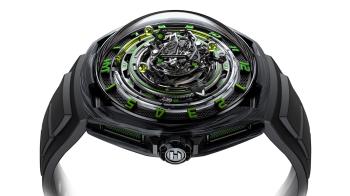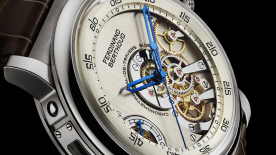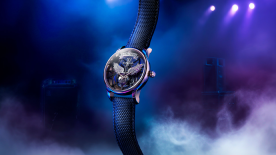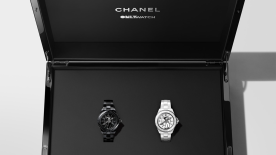This timepiece is called the “Conical Tourbillon”. Before you even see the watch, the name is intriguing. We know about single, double, triple and quadruple tourbillons. We’ve seen them flat and inclined. They can rotate around one, two or three axes. But that’s about it, because we only have three dimensions to work with. So what’s a conical tourbillon?
Mischief and humour
The creation is signed by one of the greatest contemporary tourbillon specialists: Eric Coudray. These days, he works for what used to be Tec Ebauches, now Tec-Group. He also created the Gyrotourbillon for Jaeger-LeCoultre, and more recently the Spherion, which can be found in watches by Purnell and MB&F. It’s safe to say that, where tourbillons are concerned, Eric Coudray knows his stuff. And, given that HYT’s conical tourbillon was apparently originally called the “Conillon”, it’s easy to spot Coudray’s mischievous sense of humour at work. After working in the field for 20 years, we can at least give him that.
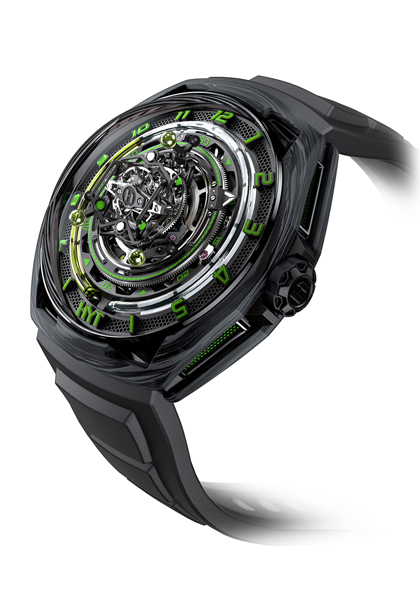
From Breguet to Daners
Coudray’s idea combines a number of different concepts, but the main driver is the idea of inclination. The pioneer in this regard was a man called Walter Pendel. In 1928, he proved that he could obtain better chronometric results using a tourbillon whose balance and hairspring assembly was tilted 30° from the horizontal. This ingenious mechanism was then enclosed in a tourbillon that rotated once every 6 minutes. Although tourbillons are generally much faster these days, this was closer to Breguet’s original conception of 1801. Indeed, Breguet’s tourbillons generally performed their revolutions far more slowly than the 60 seconds we’re used to today.
Inclined tourbillons then disappeared from the watchmaking landscape, until watchmaker Richard Daners (1930-2018) sparked a revival. Discreetly and quietly, for the 150th anniversary of Gübelin, he created a triple-axis tourbillon. This was in 2004 – the very same year that Jaeger-LeCoultre launched the Gyrotourbillon.
Did Coudray know of Daners’ work? Probably. But this temporal collision could be just a coincidence, given that Coudray had begun working for Jaeger-LeCoultre well before that year. Much later, in 2018, the idea of a tilted escapement was reinvigorated once again by Stephen Forsey and Robert Greubel, who made it a signature feature of their eponymous brand, Greubel Forsey.
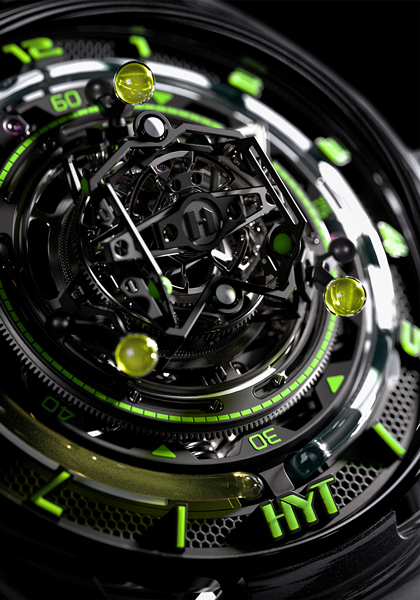
Revolutions
So where does HYT fit in? Coudray appears to have gone back to the drawing board to adapt these various different innovations to HYT’s DNA, which is highly contemporary, disruptive, liquid and phosphorescent. The result is a highly visual exercise that needs to be deconstructed to be understood.
First, there is the tourbillon. And then there are the animations around it. As far as the tourbillon is concerned, Coudray has designed an assembly whose individual components are all tilted at different angles: the balance spring is at 30° to the horizontal, the escapement wheel is at 15°, and the pal at 23°. This rapid rotation tourbillon completes each revolution in 30 seconds – a frequency Coudray is intimately familiar with, having used it for the Spherion tourbillon made by Purnell.
As far as the animation is concerned, the tourbillon is surrounded by three glass spheres filled with HYT’s signature green phosphorescent liquid. The first sphere performs each revolution in 15 seconds, the second in 12 seconds and third in 10 seconds – all clockwise.
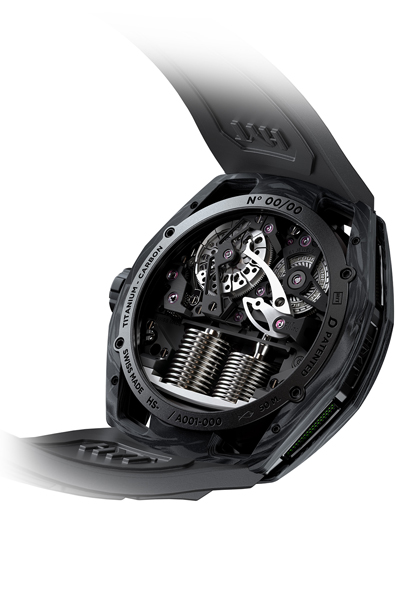
Organised chaos
HYT rightly emphasises that this desynchronisation creates an appearance of chaos. But that’s not entirely correct, because although the three spheres rotate on a peripheral cage around the tourbillon, their motion is not directly connected to that of the tourbillon itself. In fact, the tourbillon and sphere animation are mounted in series. In other words, the animated spheres are powered by the energy produced by the four barrels before it reaches the regulating organ. As a result, despite its complexity and multiple moving parts, this module maintains remarkable chronometric stability without losing precision.
750 components
To say that the construction is complex would be an absurd understatement. That’s why HYT has tasked two qualified watchmakers with producing the movement. The assembly comprises 533 parts and the tourbillon cage alone contains 159 components. If we add the 39 dial components and the 66 case pieces,, the HYT Conical Tourbillon in its entirety comprises 750 components, all of which are assembled and checked by hand.
There’s one final point. It’s easy to forget that the hour display is animated by the progress of a green fluid through a capillary that travels almost 360° around the outside of the dial. The hours remain centred. There will be just 8 of these timepieces, which will be available for CHF 335,000, exclusive of taxes. HYT has produced a very detailed video, which you can watch here.
